
About Colorado Felt & Fiber Arts
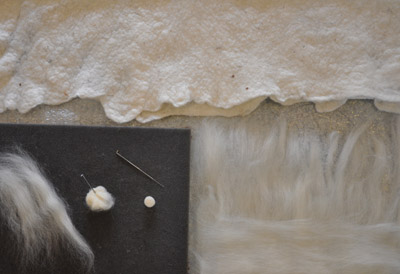
I am Kay B Dudek of Colorado Felt & Fiber Arts. I discovered felting in 2010 and established Colorado Felt & Fiber Arts soon after. A "one-woman-show", I initially focused on local craft markets to display my wares. Recently I have shifted my focus toward fine art and sculpture, and have been exploring gallery representation, art competitions, and similar venues.
What is felt? Felt is a strong fabric made from the fiber of sheep and other animals, such as alpaca, llama, yak, camel and others. Dreadlocks in human hair are essentially felt! Felt has some interesting characteristics. It repels water, can be fire retardant, and is warm and breathable. It has many industrial applications, has been used for clothing, hats, and even homes. The nomadic shepards of Mongolia continue to use felt for their transportable yurt homes to this day!
How do you make felt? There are two main approaches to creating hand-crafted felt: wet or dry. The wet felting process begins with laying out "shingles" of clean, combed fibers, followed by wetting, soaping, and gentle agitation or rolling to entangle the individual fibers. Once this process has created a cohesive fabric or "skin", vigorous agitation with soap and water (often hot) eventually causes the fibers to entangle further, and the felt shrinks into a strong solid fabric. Varying the details of the process can produce a hard, stiff material suitable for vessels or sculptures, or a soft, drapey fabric perfect for delicate clothing.
I also use a dry felting technique called needle felting. A special barbed needle, designed specifically for felting, is used on loose fiber to entangle the wool. The wool is placed on a foam pad and repeatedly "stabbed" until a dense felt mat is formed. Varying the quantity of fiber and the direction of the needle allows the wool to be sculpted, and for fine details to be added to a piece. I use this technique (generally followed by wet felting) for many of my sculptures and other art pieces. The image above shows shingles of fiber with a finished sheet of felt after using the wet technique, as well as the progression of fiber to felted ball using needle felting.
In addition to traditional felting applications, I have recently been exploring the incorporation of metals into my felt, as well as surface design, and watercolor felting.
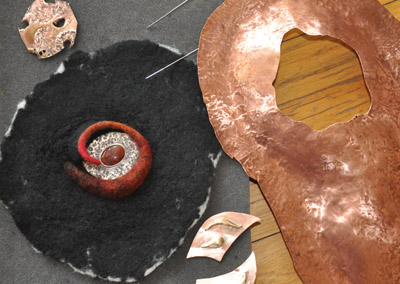
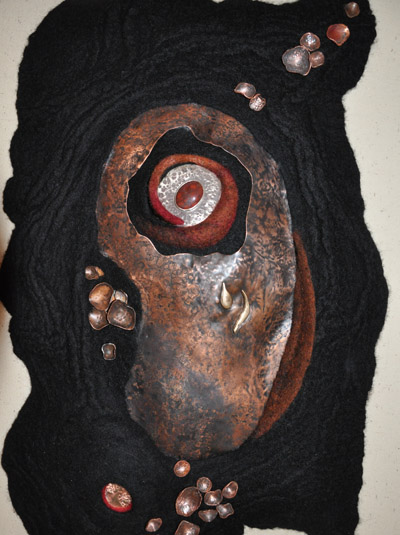
Metal and Felt
I recently have been exploring the incorporation of metal with felt. The images here show individual components of my first metal/felt project, with the finished piece to to the right.
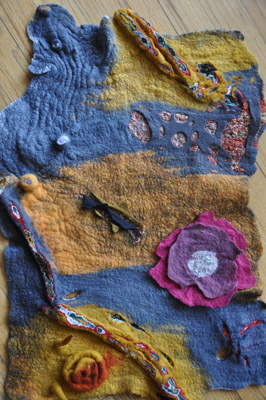
Surface Design
I am also experimenting with various types of surface design on felt. I recently attended a wonderful surface design workshop taught by Fiona Duthie. Several different techniques are included in the sampler on the right.

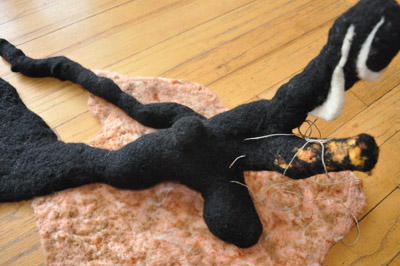
Works in Progress
My approach to felt art and sculpture often begins with a rough idea, then evolves during the felting process. I may develop an idea for a form, create it, and then use it as a component of a complete piece. I will often make "bits and pieces" when the inspiration suddenly strikes. Above to the left is an image of several of these component works in progress. On the right is the framework for another sculpture that is a bit further along.
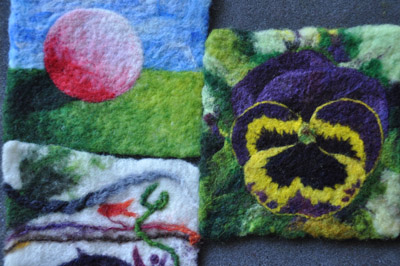
Water Color Felt
"Watercolor" felt is another special interest of mine, made even more inspiring by a wonderful course I took recently, taught by Pat Spark. This picture shows three of my projects from the class (ball and pansy designs by Pat Spark).